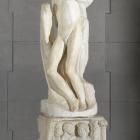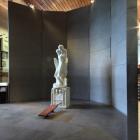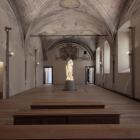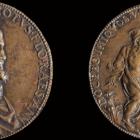Michelangelo’s sculptural group arrived from Rome on 1 November 1952 and remained in the Ducal Chapel of the Castle until the summer of 1953. For years Studio BBPR (Banfi, Belgiojoso, Peressutti and Rogers) had been managing the complex task of rearranging the Sforza Castle Museums.
Studio BBPR
The arrival of the Pietà forced the architects to substantially modify the Hall of Scarlioni, originally intended to conclude the museum exhibits with the Lombard Renaissance sculpture, well represented with masterpieces by Bambaia. To accommodate the Pietà within an isolated space, BBPR did not hesitate to demolish the 15th century vaults of the room below that of Scarlioni.
In the space thus created, surrounded by a niche in gray sandstone and reached by descending a staircase, the Pietà remained until 2015. The mounting of 1956 had the Pietà on a 1st century A.D Roman altar, which had been its base since the beginning of the 20th century.
The original solution found by BBPR for the museum found both supporters and severe critics.
In 1999 however, the placement no longer seemed appropriate and the City of Milan advertised an international competition to find a new compelling proposal for an exhibition space for the Pietà. The winner of the contest was Alvaro Siza, but his project was never realized.
The De Lucchi project and the new museum
It was only in 2012 that the then councillor of Milan, Stefano Boeri began a museological debate that convinced the Superintendent of the Sforza Castle, Claudio Salsi, to move Michelangelo’s last work to the old Spanish Hospital in the Castle’s Courtyard of Arms.
Following a long restoration of the building, on 2 May 2015 the new museum dedicated to the Rondanini Pietà, with its sober and suggestive setting by architect Michele De Lucchi, was inaugurated. A coin designed by Leone Leoni featuring a bust of Michelangelo cast in the late 16th century and a bronze portrait of the sculptor, based on his wax death mask and made by his pupil Daniele da Volterra are on exhibit together with the Pietà.












